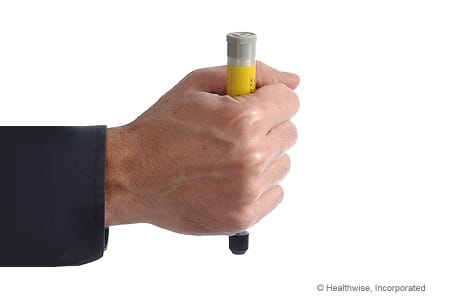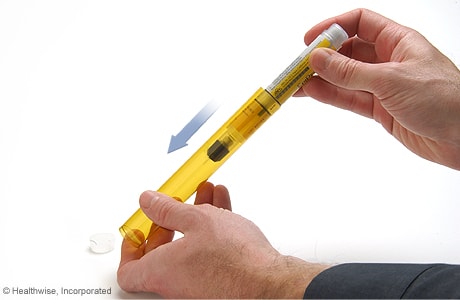Allergies: Giving Yourself an Epinephrine Shot
Overview
If you have had a severe allergic reaction (anaphylaxis) in the past, you know how frightening it can be. Symptoms of breathing problems, itching, belly pain, nausea or vomiting, diarrhea, and swelling can come on quickly and become life-threatening. Giving yourself an epinephrine shot can slow down or stop an allergic reaction. That's why it is important to have epinephrine with you at all times and to know the right way to use it. It could save your life someday.
How do you give the shot?

1. Grasp the injector in one fist with the tip pointing down. Be sure you know which end of the epinephrine shot injector is the tip and which end is the top. Do not touch the tip.

2. With your other hand, pull off the cap.

3. Give the injection.
- Hold the tip close to your outer thigh.
- Swing and jab the tip firmly into your outer thigh. Jab through clothing if you must, but bare skin is best. The injector should go straight into your skin, at a 90-degree angle to your thigh.
- Keep the injector in your thigh for 10 seconds. The injection is then complete.
- It is normal for most of the liquid to be left in the injector. Do not try to inject the remaining liquid.

4. Remove the injector and rub the skin area. After removing the injector, place your hand on the area where the medicine entered your skin. Rub the area, using a circular motion, for about 10 seconds.

5. Put the used injector—needle-first—back into its storage tube. Do not bend the needle. Screw on the cap of the storage tube.
Go to the emergency room, and bring the used injector with you.
What to do next
You should feel the effects of the medicine almost right away. These may include a rapid heartbeat and nervousness as well as improved breathing. The benefits of the shot usually last 10 to 20 minutes.
The shot does not replace the need to be seen by a doctor. After giving yourself a shot, seek emergency care. Symptoms of a severe allergic reaction can return or get worse after an epinephrine shot.
In some severe cases, you may need to give a second shot. Your doctor will explain when a second shot is needed. Make sure you understand, and ask questions if you are not sure. Too much epinephrine can cause serious side effects, such as trouble breathing.
Credits
Current as of: September 25, 2023
Author: Ignite Healthwise, LLC Staff
Clinical Review Board
All Healthwise education is reviewed by a team that includes physicians, nurses, advanced practitioners, registered dieticians, and other healthcare professionals.
Current as of: September 25, 2023
Author: Ignite Healthwise, LLC Staff
Clinical Review Board
All Healthwise education is reviewed by a team that includes physicians, nurses, advanced practitioners, registered dieticians, and other healthcare professionals.


